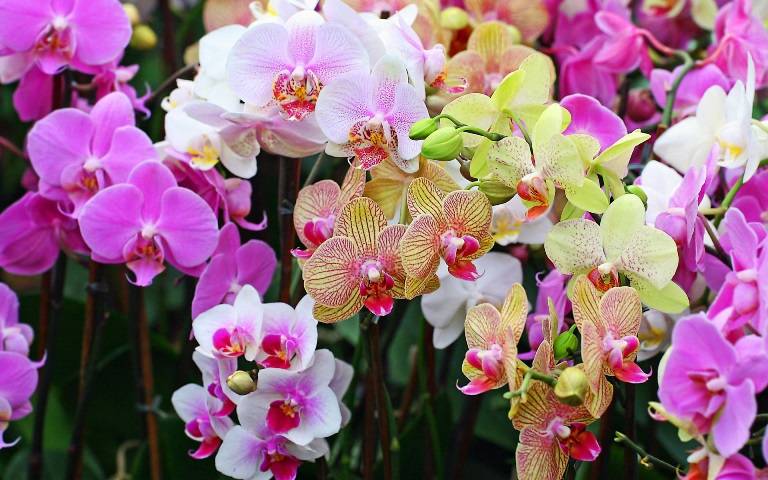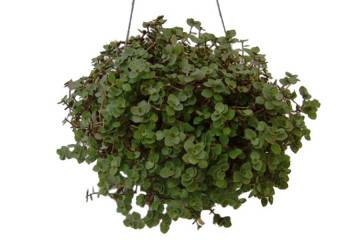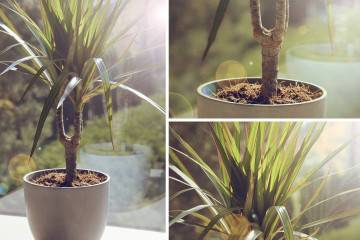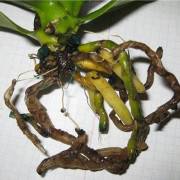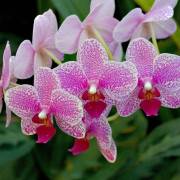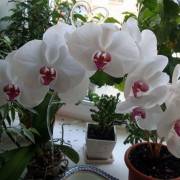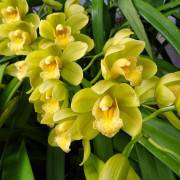Midges in orchids: how to get rid of at home and how to treat
Content:
Phalaenopsis is a beautiful tropical plant that pleases with lush flowering for a long time. The most common midges appear in orchids, how to get rid of at home, will be described below. With timely measures to destroy them, the flower will continue to grow and delight with its beauty.
Reasons for the appearance of pests on an orchid
In winter, orchid pests become especially active. This period is considered unsuitable for a tropical species. Shorter daylight hours lead to metabolic disorders. A diseased flower becomes an easy target for parasites. Other reasons for the appearance of parasites are noted:
- unsuitable temperature regime;
- low air humidity;
- a lot of nitrogen fertilizers;
- high soil moisture;
- the presence of dead leaves and flowers.
All of these reasons change the process of sap flow. The changes contribute to an increase in the number of parasites. First larvae appear, then adult pests. Both those and others choose juicy green shoots, leaves and buds for food.
Areas with insects are covered with white bloom, so the presence of parasites is immediately visible. Sugar discharge is another sign of pests.
Types of midges
If midges are in the orchid, not every florist knows what to do. The problem is familiar to many houseplant lovers. Treatment can be challenging as the parasitic species spreads quickly and the increased population will take a long time to fight. It is possible to quickly destroy pests, but at the early stages of development. At the same time, it is important to know who you will have to deal with.
Thrips
These are small insects about 1-1.5 mm in size, which have paired wings. The California thrips species usually live on orchids. If midges are in orchids, then how to get rid of is an urgent question of the grower, since insects are carriers of viruses. From them, the plant can die in a matter of days. In addition to the Californian subspecies, the following can settle on a home plant:
- tobacco thrips;
- American thrips;
- black thrips.
Pest larvae reproduce in the leaves. The development of the young leads to dehydration of the plant, since the affected trunk does not receive sufficient nutrition.
Whitefly
A pest that lives on indoor flowers and garden plants. If these midges are in the orchid, you need to urgently take action.
The insect is a small white butterfly. With a large accumulation of species on orchids, the leaves turn yellow and dry out. An adult butterfly easily moves between plants, laying its larvae in the roots, sometimes on the back of the lower leaves. In unkempt plantings, the tops of the plants are also affected. Manual collection of larvae and capture of adults are recommended as the main control measures.
Sciarids
These insects are also small, fly, and the larvae reproduce in the soil. Breeding young growth harms roots and young growth, leaving behind rotting residues.
Due to their small size, sciarids seem harmless. They really are not able to completely destroy the orchid, but they carry diseases due to which the plant dies. Rotting organic matter attracts even more insects.
A large number of larvae eat the roots, weakening the development of aboveground organs. Sciarids are ubiquitous.
Fruit flies
These are common midges, familiar not only to plant lovers. They appear in apartments with the arrival of heat, they reproduce very actively. It is difficult to fight with a large number of midges.
Common fruit flies are yellowish in color, with red eyes. Insects are also called fruit midges. When they appear on orchids, yellow stains become noticeable. Young plants, thin leaf plates especially suffer from midges. If midges appeared in the orchids in the ground, what to do is to start processing. If you do not start a fight, the reproduction of yellow midges occurs very quickly. One individual lays up to 400 eggs.
Home pest control options
All plant growing lovers face plant pests. Various methods of fighting at home are used.
Folk ways
Folk remedies, although they require a lot of effort in preparation, have a rather beneficial effect on the plant itself. You can get rid of pests with proven means, for the manufacture of which you will need:
- citrus peels;
- garlic and onions;
- laundry soap;
- tobacco;
- potassium permanganate;
- various herbal infusions and decoctions.
When diagnosing a pest infestation on an orchid, it is important to do the following right away:
- the plant must be removed away from other domestic specimens;
- use a solution of laundry soap;
- remove visible pests and plaque from plant parts;
- arrange a warm shower for the flower;
- move the orchid closer to the light, but not to the sun;
- carry out root treatment.
Chemicals
Strong medications are generally not recommended for home use, but there are options specifically designed to combat orchid pests.
The form of release of most drugs is a liquid solution, on sale is presented in ampoules. Application is possible both at an early stage of plant disease, when the first symptoms appear, and at the late development of a pest colony.
The concentration of the working solution is indicated on the label, the efficiency is best at positive temperatures. It is not recommended to use one chemical preparation more than twice. Insects get used to the action of the components. Spraying can be carried out both during the growing season and during the dormant period. For processing, only fresh solutions are usually used.
Biological methods
To combat orchid diseases, there are modern biological preparations:
- bicol;
- bitoxibaccillin;
- lepidocide;
- verticillin;
- non-abact.
Biological insecticides are safe for home use. Of the advantages of using them, they note:
- safety for pets;
- plant safety;
- lack of addiction in pests.
Prevention of infection
To exclude pests, it is important to initially choose the right flower. It is better to choose special stores for purchase. The purchased plant can be tested immediately. You need to place the orchid right in the pot in a bowl of water. It is enough to soak in liquid for 8-10 minutes. Next, the plant must be pulled out, placed in a place isolated from other plants and observed. In the presence of insect pests, movement or a change in the appearance of the flower will be noticeable.
Most individuals die from high temperatures. It is recommended to transplant a new plant into a soil mixture treated with boiling water. The substrate must be kept until it cools completely.
Treatment with biological agents is recommended as a preventive measure. For example, phytoverm preparation will not bring harm. You can use folk remedies such as soapy water.
Further care of the plant
The plant needs special care. Among its stages:
- thorough inspection;
- collection of the remaining insects;
- removal of damaged parts;
- re-immersion in water.
In general, orchids are quite resistant to pests, but problems sometimes occur due to improper care. For example, midges on a plant appear due to waterlogged soil. The number of insects decreases when you change the watering regime to the correct one. It is advisable to remove the affected areas of the flower. The plant needs bactericidal treatment.
For an orchid, light is important. There should be a lot of light, it should be diffused. Direct sunlight is not allowed. Watering should not be too frequent and abundant. Orchids love a moderate amount of water in the soil and good hydration of the leaves.
It is important for an amateur florist to be able to determine the type of insect that has harmed the plant. This will help in taking preventive measures. Correctly chosen methods reduce the risk of flower death, increase the success of getting rid of pests.
If a plant is not sick and is properly cared for, it is unlikely to be seriously attacked by insect pests. Regular use of preventive measures is a reliable barrier against pest attacks.






